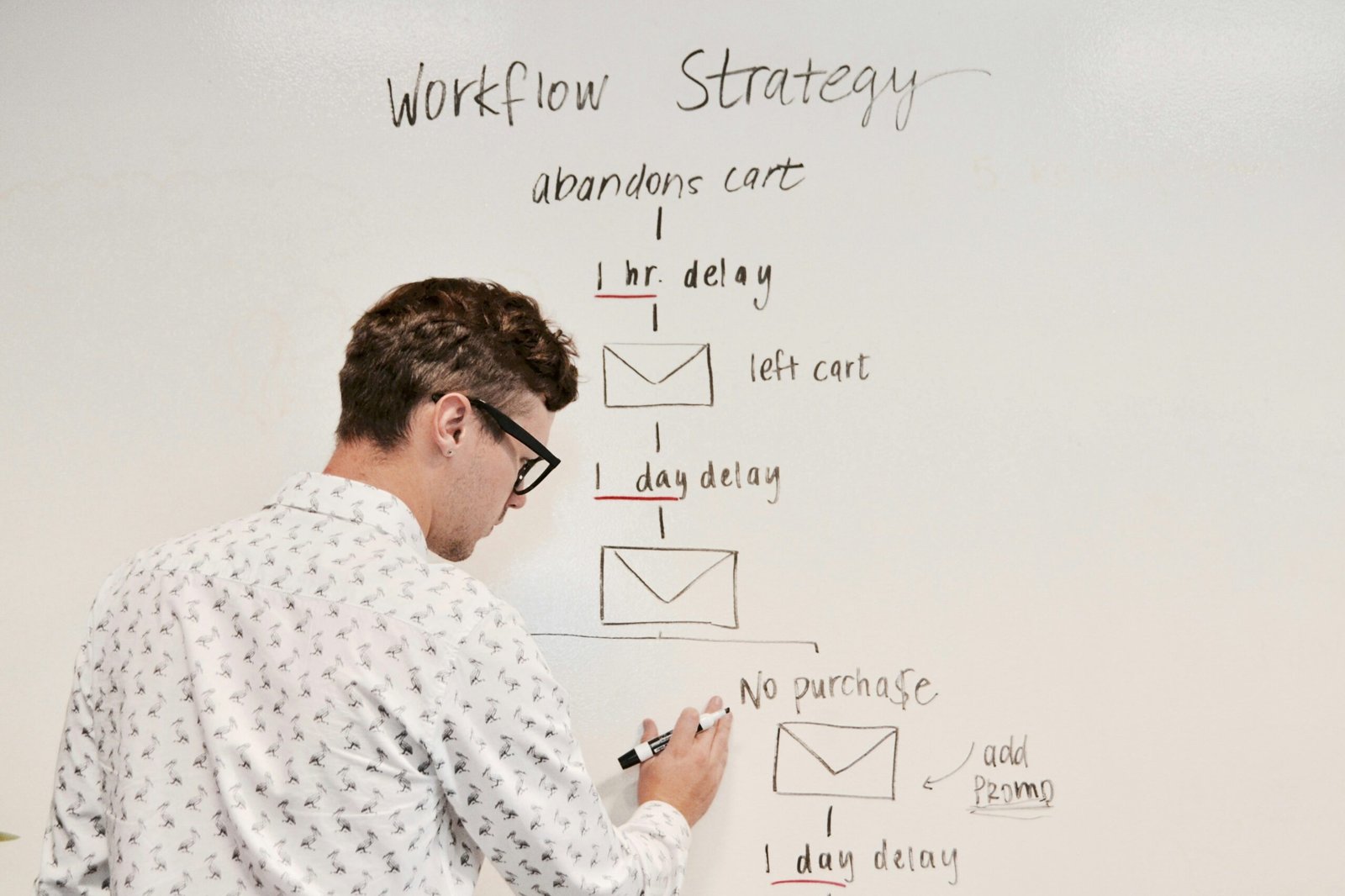7 Types of Effective SaaS Education Content
Introduction to SaaS Education Content
SaaS education content refers to a variety of materials and resources designed to inform and assist users in effectively utilizing software as a service (SaaS) solutions. In an age where digital transformation is paramount, the importance of such content cannot be overstated. Educating customers about SaaS products enhances their understanding and ensures they are able to leverage the software to its fullest potential. This knowledge not only helps in driving user engagement but significantly contributes to customer retention.
Effective SaaS education strategies empower users to navigate and utilize features efficiently, reducing frustration and increasing satisfaction. When users are well-informed about the functionalities of the software, they are more likely to adopt the product seamlessly, fostering a positive user experience. Effective education content takes various forms, including tutorials, webinars, user manuals, and FAQs. Each of these materials serves a specific purpose in guiding customers through their journey and enhancing their competency with the software.
Furthermore, crafting high-quality SaaS education content establishes a sense of trust and reliability between the provider and its customers. When users feel supported and educated about the product they are using, it creates a loyal customer base that is more inclined to renew subscriptions and advocate for the software within their network. Ultimately, the integration of comprehensive educational resources into SaaS offerings not only aids in product adoption but also facilitates ongoing customer success, ensuring that users maximize the benefits of the software over time.
1. Onboarding Guides
Onboarding is often the first meaningful interaction customers have with your software. These guides need to be both comprehensive and intuitive, offering step-by-step instructions that help users understand the essentials without bogging them down with excessive details.
In the realm of Software as a Service (SaaS), effective written guides and documentation play a crucial role in facilitating user understanding and engagement. These resources serve not only as reference materials but also as essential tools for onboarding new users and addressing their queries throughout their journey. Comprehensive documentation types include user manuals, frequently asked questions (FAQs), and troubleshooting guides.
User manuals deliver step-by-step instructions on utilizing the software, ensuring that customers can navigate features and functionalities with ease. Meanwhile, FAQs serve as a quick reference encompassing common inquiries, potentially reducing the volume of support requests. These documents should be clearly structured and easy to locate, as users often seek swift answers to their concerns.
Moreover, troubleshooting guides are vital for resolving technical issues that users may encounter. They should provide systematic approaches to diagnosing problems, alongside potential solutions, allowing users to self-service their technical difficulties without the need for direct support. This not only enhances user satisfaction but also fosters independence and confidence in using the SaaS product.
To maximize the effectiveness of written guides and documentation, several best practices must be adopted. Firstly, clarity is paramount; complex jargon should be minimized in favor of simple and straightforward language. Secondly, organization is key; utilizing headings, subheadings, and bullet points enhances readability and allows users to skim for relevant information quickly. Additionally, including visuals such as diagrams or screenshots can significantly aid comprehension, offering users a visual context for the information being conveyed.
Accessibility is another critical aspect, ensuring that documentation is readily available on the company website or within the application. With effective written guides and thoughtful documentation, SaaS providers can empower their users, leading to improved satisfaction and loyalty.
Why they work: Onboarding guides reduce the intimidation factor that often comes with using new software. They provide an immediate sense of accomplishment and progress, making the user feel confident that they’re in control.
How to use them: Break your onboarding guide into phases. Start with the basics, but offer expandable sections or “advanced” links for users who want to dive deeper. Multimedia like short videos or GIFs can transform dull text into an engaging learning experience.
2. In-Depth Blog Content & Articles
Blog posts can serve as a powerful educational tool when they go beyond surface-level content. In-depth blog posts that explain industry trends, solve specific pain points, or dive deep into a feature create long-term value for both your customers and your SEO strategy.
In the landscape of Software as a Service (SaaS), blog content and articles serve as a cornerstone for delivering educational resources to users and potential customers. They offer a platform to provide in-depth insights into various topics relevant to SaaS products, from usage tips to emerging trends within the industry. Well-crafted blog posts can significantly enhance users’ understanding and engagement with the software, fostering a knowledgeable customer base.
To effectively harness the potential of blog content, a structured content strategy is essential. This begins with identifying the target audience’s needs, challenges, and interests. By addressing these aspects, content creators can produce valuable articles that resonate with readers. Furthermore, incorporating best practices in writing, such as clear headlines, subheadings, and bullet points, can greatly improve readability and user experience.
Search Engine Optimization (SEO) techniques play a critical role in amplifying the visibility of blog content. Employing relevant keywords, meta descriptions, and alt texts can enhance a blog’s ranking on search engine results pages. However, it is crucial to maintain a natural flow in the content, avoiding keyword stuffing which can lead to adverse effects on reader engagement and SEO rankings. Utilizing synonyms and related terms can ensure diverse language while optimizing the content effectively.
Additionally, engaging readers and encouraging them to return for more requires consistent publishing schedules and interactive elements such as comment sections, polls, or sharing options. Incorporating multimedia, such as images, infographics, or videos, can also enrich the reading experience and facilitate a deeper understanding of complex topics. By focusing on these strategies, SaaS companies can leverage blog content as a potent educational asset that drives both user engagement and brand loyalt
Why they work: Well-researched, detailed blog posts position your SaaS company as a thought leader. When users search for specific solutions, your blog posts can rank highly and introduce them to your software. It’s a win-win: you educate them on the topic while subtly promoting your product’s benefits.
How to use them: Focus on writing evergreen content—posts that will remain relevant and useful for a long time. Use data, examples, and visual aids to explain complex topics, and always tie the content back to how your software can help solve the issues discussed.
3. User-Generated Content
Sometimes the best educators are your customers. User-generated content, such as forums, community posts, and customer-created tutorials, creates a sense of trust and relatability that can’t always be achieved through official company materials..
Why they work: Users trust the experiences of their peers. When they see others like them using and benefiting from the software, it reinforces their decision. Additionally, user-generated content fosters a sense of community, encouraging customers to help each other.
How to use them: Create spaces where users can share their experiences, ask questions, and offer solutions. Encourage active participation by recognizing top contributors or offering incentives. Use user-generated content as a resource for future educational materials, such as featuring a particularly insightful forum post in your blog or email newsletter.
4. Feature Walkthrough Videos
In the world of SaaS, seeing is believing. Video walkthroughs that highlight key features of your software provide a dynamic way for users to see the product in action. More importantly, they allow prospects to visualize how the software solves their problem.
Video tutorials have become an essential tool in the realm of Software as a Service (SaaS) education content. They provide a powerful means for users to engage with complex software by offering visual learning experiences that can significantly enhance understanding. The advantages of video tutorials include their ability to present information in a visually rich format, catering to various learning styles. Users often benefit from immediate feedback through visuals, demonstrating features and functionalities in real-time.
When creating effective video tutorials, adherence to best practices is vital for maximizing engagement and educational value. The length of the tutorial plays a critical role; ideally, videos should be concise, lasting between three to five minutes, to maintain viewer attention without overwhelming them with information. Videos should be structured logically, beginning with an overview of the topic, followed by a step-by-step explanation of the process, and concluding with a recap or important takeaways. This structure aids in reinforcing learning outcomes and ensures that essential content is delivered effectively.
Accessibility is another important factor in video tutorials. Implementing closed captions, ensuring compatibility with various devices, and considering different language options can help reach a broader audience. Successful examples of SaaS companies utilizing video tutorials include platforms such as HubSpot and Salesforce. HubSpot’s extensive collection of video tutorials guides users through their marketing tools, while Salesforce employs a mix of video content to educate users about its features and best practices. These companies exemplify how video tutorials can enhance user experience and facilitate smoother onboarding processes for new customers.
Why they work: People often remember visuals more easily than they do written instructions. Feature walkthrough videos offer a tangible demonstration of value while being easy to digest. They also build trust by showcasing your product’s real-life functionality.
How to use them: Keep your videos short—aim for no longer than 2-3 minutes. Focus on one key feature per video, and always include a CTA at the end. Encourage viewers to take the next step, whether it’s trying out the feature themselves or exploring additional functionality.
5. Webinars and Live Demos
Webinars and live demos offer an interactive way to educate your audience. They combine the structure of a tutorial with the added benefit of real-time engagement, allowing for live Q&A and hands-on demonstrations.
Interactive webinars represent a powerful educational tool within the Software as a Service (SaaS) model, allowing for real-time engagement between educators and users. Unlike traditional forms of content consumption, webinars provide a dynamic platform where participants can ask questions, share insights, and engage in discussions, thereby creating a more enriched learning experience. By integrating interactive elements such as polls, Q&A sessions, and breakout discussions, presenters can foster an environment that encourages active participation and collaboration.
To ensure the effectiveness of interactive webinars, several key strategies should be employed. First, it is essential to have a clear agenda that outlines the objectives of the session. This helps participants understand what to expect and stays focused on the relevant topics. Moreover, utilizing high-quality audio and video equipment enhances the overall experience, minimizing distractions that may detract from the learning process. Engagement can further be stimulated by encouraging participants to share their experiences and insights, thus contributing to a more communal atmosphere.
Post-webinar strategies are equally vital in maximizing the value of the session. Sending follow-up emails to all participants can reinforce the lessons learned during the webinar and provide additional resources for deeper understanding. This communication may include links to relevant articles, recordings of the session, and answers to unanswered questions raised during the event. Integrating this feedback into future webinars can also help refine content delivery and address audience needs more accurately, fostering a continual improvement cycle.
All in all, interactive webinars stand out as an effective method for imparting SaaS knowledge, bridging the gap between theoretical understanding and practical application. By implementing thoughtful preparation, fostering engagement during the session, and maintaining post-webinar communication, educators can enhance learning outcomes significantly.
Why they work: Webinars give you a platform to directly address common questions and showcase your product’s benefits in a controlled environment. Live demos add an element of immediacy, giving prospects a chance to ask specific questions and see the product respond in real-time.
How to use them: Schedule your webinars around common pain points or frequently asked questions in your industry. Promote them through email campaigns, social media, and your website. After the webinar, repurpose the content by offering a recorded version as gated content or a downloadable asset.
6. Interactive Tutorials
Interactive tutorials allow users to learn by doing. Instead of passively watching a video or reading a guide, they can engage with the product in a simulated environment. This hands-on approach helps them gain practical skills they can apply immediately.
Why they work: Interactive content keeps users engaged longer, and learning by doing is proven to increase retention. These tutorials also empower users to explore the product on their own terms, giving them a sense of control and mastery.
How to use them: Start small. Offer tutorials that guide users through one specific task or feature. Include checkpoints where users can test their knowledge or get instant feedback. For more complex software, consider adding hints or tips along the way to guide them.
Online community forums play a pivotal role in the education of Software as a Service (SaaS) users. These platforms facilitate user-generated content, allowing customers to post questions, share experiences, and provide answers to common challenges. For new customers, such forums serve as invaluable resources where they can quickly find the information they need, often without requiring direct support from the service provider. This reduces the burden on customer support teams and enhances user satisfaction.
Moreover, community forums foster a sense of belonging among users. They create an environment where customers can connect, discuss, and learn from peers who share similar experiences. This interaction often leads to the formation of strong community bonds, which can enhance customer loyalty and retention. As users engage with one another, they contribute to a rich repository of knowledge that is continuously updated and refined based on real-world applications and solutions.
To effectively nurture these online community forums, several strategies can be implemented. Firstly, it is essential to have a dedicated moderator or community manager who can guide discussions, ensure adherence to community guidelines, and facilitate engagement. Regularly posting updates, insights, or topic starters can also stimulate conversation and encourage participation from more reticent users. Furthermore, integrating gamification elements—such as badges or leaderboards for active contributors—can incentivize participation and knowledge sharing.
In essence, online community forums are not merely platforms for discussion; they are vital educational tools that empower users through shared experiences and collective problem-solving. By fostering an active and engaged community, SaaS providers can enhance the overall user experience, leading to better product adoption and customer loyalty.
7. Case Studies and Success Stories
Case studies and success stories serve as powerful tools in educating both potential and current users about Software as a Service (SaaS) products. By showcasing real-world applications of a product, these narratives effectively illustrate the tangible value that such services can offer to organizations. Users are more inclined to engage with content that incorporates specific examples of how others have achieved success, thereby creating a relatable context around the software’s practical capabilities.
The significance of these case studies lies in their ability to encourage product trials among prospective customers. When potential users observe how similar businesses have leveraged a SaaS solution to overcome challenges or enhance efficiency, they are more likely to envision themselves achieving similar results. This can lead to increased inquiries and conversions, making case studies an essential component in the customer acquisition strategy.
Incorporating success stories into educational content also offers a platform for demonstrating effective usage strategies. By revealing the methods employed by successful clients, companies can provide invaluable insights into best practices. This not only aids in client education but also fosters a sense of trust instilled by transparency. It’s important to highlight measurable outcomes, such as improved productivity metrics or cost savings achieved through the service, as these figures lend credibility to the claims made and further enhance user engagement.
When crafting compelling case studies, adhering to best practices is crucial. Begin with a clear objective, outlining the challenges faced by the client prior to using the product. Detail the implementation process, followed by the results achieved post-adoption. Utilize visually appealing elements, such as graphs and testimonials, to enrich the narrative. Ultimately, effective case studies not only elevate the educational value of SaaS content but also drive user interest, making them a vital element in a SaaS company’s marketing arsenal.
Case studies offer concrete examples of how other companies have benefited from using your software. By sharing specific data and real-world scenarios, case studies lend credibility and demonstrate your software’s potential impact.
Why they work: Case studies take your product out of the hypothetical and into the practical. They offer social proof, a powerful psychological motivator, by showing how similar companies achieved success with your software. They also help potential customers see themselves in the story.
How to use them: Focus on the challenges your customers were facing before they found your solution, and then clearly outline the measurable outcomes they achieved. Include testimonials and data points where possible, as these add to the story’s authenticity
Conclusion and Final Thoughts
In today’s rapidly evolving digital landscape, the significance of diverse SaaS education content types cannot be overstated. As businesses strive to enhance user experience and satisfaction, incorporating various forms of educational materials is essential. The blog post has outlined seven effective types of SaaS education content, including tutorials, webinars, case studies, and knowledge bases. Each of these formats serves a unique purpose and addresses distinct aspects of the user journey, making them integral to a comprehensive content strategy.
Leveraging a diverse array of educational content can help SaaS companies cater to different learning preferences and knowledge levels among their users. For instance, while some users may prefer in-depth tutorials and instructional videos, others might find quick reference guides or FAQs more beneficial. By recognizing these varying needs and preferences, organizations can tailor their content strategies to improve engagement and retention rates.
Moreover, a well-rounded approach to SaaS education can foster a sense of community among users, encouraging collaboration and support. Content that invites user interaction, such as forums or live Q&A sessions, can enhance the overall learning experience and strengthen customer relationships. As companies assess their current educational offerings, it’s crucial to identify gaps and explore opportunities for implementing different content types.
In summary, the creation and integration of multiple types of SaaS education content can significantly benefit user satisfaction and loyalty. As you reflect on your current strategies, consider the various educational mediums discussed in this post. Embracing a more diverse content approach could lead to enhanced user experiences and ultimately drive the success of your SaaS business.







